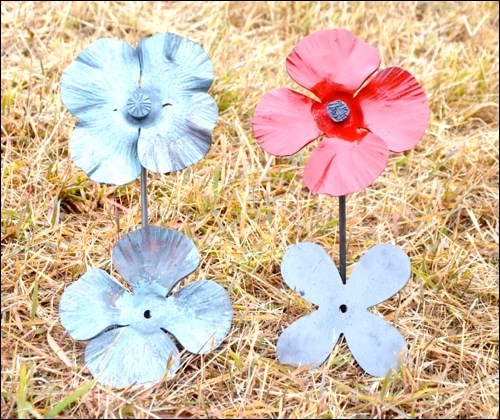UNITY – A call from “Mom” back home in Great Britain in the spring led to Paul Marshall of Unity to becoming part of a large international collection of metal forgers and blacksmiths who contributed to a First World War memorial being installed on the battlefield at Ypres, Belgium. The memorial will be unveiled Nov. 11.
Marshall’s mother heard about the project on a news show, and heard there was an appeal being made for 2,016 poppies to be built for the foot of this cenotaph. Marshall looked into it, called the organizers and decided he’d like to participate. He said he’s always been interested in the sacrifices made by soldiers and civilians in the World Wars.
The British Artist Blacksmiths Association and the Belgian Guild of Blacksmiths organized the project. A British blacksmith explains in an introductory video on the ypres2016.com website: “We need a field of 2,016 poppies around the base of the cenotaph. Although each one will be unique, it’s important to remember we’re looking for uniformity as part of the symbolism is that we are all equal in death.” Each metal poppy is approximately six inches wide.
Marshall created and sent a container of 50 metal poppies to be part of the field of poppies surrounding a 23-foot tall, six and a half foot wide and four-inch thick, solid steel pillar. The Ypres2016 website provides the following description of the cenotaph: “The cenotaph, designed by Terrence Clark, comprises a seven-metre tall by two-metre wide pillar of steel, incorporating a Flanders Field poppy, in negative and positive form, symbolizing both those who fell and those who returned, their families and communities. Around this will be a field of forged steel poppies, all surrounded by a low railing, designed … to echo the characteristic meandering form of the trenches.”
Marshall purchased a large sheet of steel from Russell Metals and, when he told them what it was for, “with no hesitation,” the company cut the poppy blanks out of the sheet for Marshall at no charge. Marshall’s primary donation to the overall project was the cost of the steel itself and doing the work.
He also sent the poppies to Ontario from where they were sent to Belgium. A large international machine company had undertaken to ship the completed poppies, from all over the world, to Belguim.
Marshall has a coal forge but he used a propane forge, lent to him by Cam Sperle, to make the poppies. Helping him run the forge at various times were Keith Wilson, Mike Welter and Pat Welter. Helping by keeping the petals in the forge, rotating them and handing them to Marshall definitely helped make the task move along quicker. Marshall also had 12-year-old Holdon Moncrieff of Chauvin, Alta., helping one day.
Because it would make shipping more difficult, stems and stamens were not added to the poppies Marshall sent to Belgium. His sheet of steel, however, produced more than 50 poppies – 50 were how many fit in the shipping drum.
Two of the extra poppies Marshall created, complete with stems and stamens, have been added to the cenotaph at the Senlac cemetery. During the time Marshall was working on the poppies, Pat Welter was refurbishing that cenotaph.
Marshall said, “I’m really glad Mom rang me and gave me the opportunity to contribute to something important to me. And I learned how to use a trip hammer too, so that was a bonus.”
Marshall grew up on a farm that billeted many Canadian soldiers during the Second World War and heard many stories growing up, from both of his parents, about wartime.
Canadians sent approximately 220 poppies and Marshall’s 50 was the most contributed by any one Canadian. One Canadian provided just one poppy – a high school student who created it as his shop project for the year.
Along with the main cenotaph and the field of poppies, will be a series of artistic metal panels, also built by blacksmiths from around the world. Each panel illustrates its creator’s interpretation or view of war. These metal workers assembled in Ypres to build their panels for a week in September. Ten forges were set up in the town centre as part of this international blacksmithing event.
Sandra Dunn from Ontario is a Canadian blacksmith who participated in the event and created one of the 25 panels, with the help of volunteers who had also come to Ypres for that purpose.
Other panels were created by blacksmiths from Chile, Germany, Russia, Norway, Italy, the United States, Czech Republic, South Africa, Scotland, the Netherlands, Japan, Australia, Palestine and China, as well as the Belgium and the United Kingdom. Those countries and more have also contributed poppies to the project.
Panel builders were chosen through a design competition; their designs and explanations can be viewed at www.ypres2016.com/design/masters-panel-designs/.
Everyone who worked on the project, including the panel designers who congregated in Ypres for a week, did so as volunteers, paying their own way. The British and Belgium blacksmiths leading the initiative have spent a year on it.
When one learns that a million soldiers from 50 different countries were killed or wounded in the Flanders Fields area, the international contributions to the Ypres cenotaph become especially meaningful.
One of the master blacksmiths helping lead the project says, in another video on the website, “I’m hoping you guys around the world can make as many as possible and send them over … This is to remember all soldiers and civilians on both sides of the war, so this is to remember everybody.”
One white poppy will also be installed, to remember those shot by their own countrymen for what was then termed cowardice, but later recognized as shell-shock and today termed post-traumatic shock syndrome.
“So it’s truly to remember everybody,” said the blacksmith.




